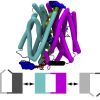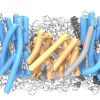
Flexible Gates Generate Occluded Intermediates in the Transport Cycle of LacY
We show that one of the best-studied secondary active transporters, the lactose permease LacY, goes through an occluded conformation during its transport cycle. We propose an atomically detailed model of the apo-occluded state. The simulations predict the formation of a transient salt bridge that has been hypothesized in the canonical model for transport of LacY. The simulations are validated by comparison to experimental EPR DEER data, using a new approach to simulate spin-label distance distributions through post-processing of molecular dynamics trajectories. We also define a set of order parameters that consistently classify all known MFS transporter structures as outward-open, occluded, or inward-open conformations.




